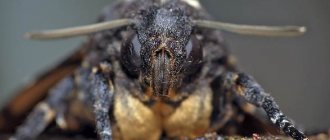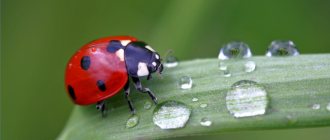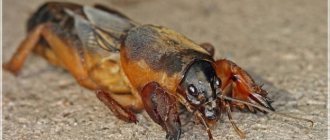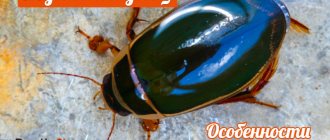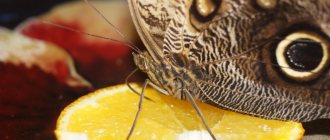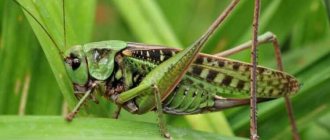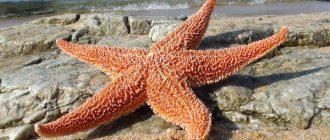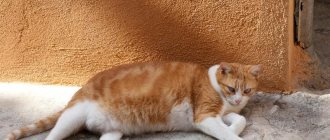- Wild animals
- >>
- Insects
Almost everyone who rested on the shore of a lake or river came across a swimming beetle . This dexterous insect is a merciless predator and attacks many river creatures. These beetles do not show aggression towards humans, but if they feel threatened, they can bite. The bite of a diving beetle is not life-threatening, but quite painful.
Description of the swimmer and its specifics
The swimming beetle spends the vast majority of its time in the aquatic environment. In order to ensure ease of movement, nature gave him a streamlined body that allows him to move dynamically with minimal resistance.
The average size of an adult insect is about 5 cm. The color range includes shades from brown to black.
In the photo of the diving beetle you can see that its body consists of an abdomen, a thorax and a head. The insect has 6 legs. The two front pairs are designed to be attached to plants.
They are equipped with hooks that provide a secure fit. The beetle is an excellent swimmer, since its hind legs serve as oars and help the beetle develop solid speed when moving in the water.
The wings of the diving beetle are well developed. But the insect rarely uses them, since it spends most of its life in water. Beetles fly only when it is necessary to look for a new place of residence due to the drying up of a reservoir, or in search of food.
Insects are excellent at navigating the aquatic environment. They are helped in this by their unusual eyes, consisting of several thousand small facets.
Swimming beetles have powerful, sharp jaws that allow them to eat live prey.
Most of the swimmer's life is spent in the underwater environment, but it needs a regular supply of oxygen. Every 15 minutes he has to float to the surface for a new portion of air.
The pores through which oxygen enters are located on the abdomen, the insect turns over on its back, receives the necessary dose of air, and is again immersed in water.
Replenishing your oxygen supply is required for more than just breathing. The beetle's body has a special sac that contains air. It is needed for the processes of diving and ascent.
| Lifespan | 1-2 years |
| Basic food | Insects fish fry small fish tadpoles and frogs |
| Main Enemies | large fish mammals living near water birds insect rider |
What to eat, lifestyle
The diet of the dung beetle is excrement, carrion, and mushrooms. They prefer to feed on cattle feces and manure - this is where the name comes from. They eat at home, pulling food into their burrow, which is placed at a depth of 15 to 50 cm.
Eating dung beetle
The excrement is rolled into balls of the correct shape. They roll to their place of residence, making incredible efforts. The weight of the food is several times greater than his own. Dung beetles can roll balls on the ground with their front and hind legs.
To prevent food from drying out, the beetles bury it underground, and when they get hungry, they take it out. Often in the process of rolling balls, clashes occur. The winner takes the prize. In hot weather, food protects dung beetles from overheating. The beetle climbs onto the ball, and after a few minutes its body temperature drops several degrees.
The big hard worker is active at night, during the day he hides in a hole or a secluded place, away from the light. Often a dung heap serves as a refuge for him. It determines the location of food by smell, flies through the air or crawls along the ground. During the flight, a heavy hum is created, and the landing is always “rocky”. It just falls to the ground.
In addition to feces, the beetle eats carrion and mushrooms. For this he is called the pasture cleaner. Dung beetles drink water in a special way. In the morning or evening, they spread their wings, droplets of dew collect on them, which gradually roll into the mouth.
Main types of diving beetles
The diving beetle family includes more than 600 species. In order to know what swimming beetles look like, you need to know the characteristics of the varieties. Several representatives live in the middle zone:
Banded swimmer dytiscus marginalis
This type is the most common. It got its name because of the ocher border that frames the body. Populations of these aquatic insects are found in American and Japanese reservoirs, water areas of European countries, and in the Yakut region. The size of an adult beetle is about three centimeters.
Latissimus or broad swimmer dytiscus latissimus
These are the largest representatives of swimming swimmers. Their length can exceed 4 centimeters. Only clean water is suitable for these individuals to live.
Pollution of water bodies with products of human activity and environmental deterioration have led to a sharp reduction in their numbers.
In several countries, the insect is listed in the Red Book.
Sulcata acilius sulcatus
This beetle's favorite food is tadpoles. This determines habitats. Insects settle in reservoirs with stagnant water, in which frogs and small fish are found.
An adult beetle grows up to one and a half centimeters. Populations of stripers exist in Russian waters, North African regions, and East Asian countries.
Pond snail colymbetinae
Pond snails live in overgrown, abandoned ponds. The color of the insects is dirty brown; the wings have a pattern of transverse relief.
Ilnik rhantus
This family includes more than 100 species. Ilnik is not large in size, reaching a length of about 1 cm.
These insects differ from their counterparts in color. There are yellow-bellied and black-bellied eelgrass. The wings are red or yellow, covered with black dots.
Ilnik prefers swampy bodies of water.
Popular representatives of the diving beetles include flat and marsh divers. Like elnik, they are small in size. Adults reach 5 mm. These insects are found in lakes and slow-flowing rivers.
Lifestyle
The water lover is predominantly nocturnal, preferring to fly out on a warm moonlit night. The beetle has many enemies, from which it defends itself by making an unpleasant grinding sound with its elytra. The water lover can scare off the enemy in another way, by releasing a paste of unpleasant odor from the body.
The fringed swimmer and the great water-lover also differ in habits. When surfacing, the water lover sticks his head out and draws in air with his antennae. As a result, oxygen envelops the abdomen from below, forming a kind of bubble. The swimmer takes in air, rising up with its belly.
The main habitat of the large water lover is a reservoir, pond or river; the fringed swimming beetle can live in both running and standing water. The food of the large water lover is algae, rotten parts of aquatic plants, the remains of dead insects and river fish. If you keep such beetles at home in an aquarium, you can feed them with aquarium fish food, bloodworms, tubifex, and even lettuce or dandelion leaves.
Pennywort
The swimmer is a predator that attacks all small aquatic inhabitants: snails, tadpoles, insects, crustaceans, and fry. The swimming beetle and its larva are the most dangerous enemies of fish, as they eat not only fry, but also fish eggs.
Reproduction of swimming beetles and life expectancy
The mating period begins in the spring. Males have suckers on their front legs, allowing them to firmly attach themselves to the female. The process can last up to 48 hours.
During this time, only the male whose abdomen is above the water can carry out high-quality air intake. If a female has had several matings in a row, she dies from lack of oxygen.
After the process, the female immediately seeks shelter, as the males can use her as easy prey. It lays larval eggs on the leaves and stems of plants, secreting a special sticky substance to firmly attach them.
For the most part, beetles are used for laying:
- cattail
- iris
- marigold
- calligraphy
- arrowhead
The duration of the egg development period depends on the water temperature; it can last 8-40 days. After molting, the emerging larvae move to land and bury themselves in soft soil for pupation.
The insect remains in this stage for about two months, after which an adult emerges from the pupa. She sits in her hole for several days so that the covers completely harden, then she leaves it and goes to the water.
How long the swimming beetle lives depends on various conditions. On average, life expectancy is 1-2 years.
At home, a pet can live up to 3 years.
Rules for aquarists
Tips for beginner aquarists:
- Watch the behavior and appearance of the fish. The color should be rich, the eyes should not be cloudy. If you have any suspicions, contact experienced aquarists, describing in detail the problem, the parameters of the aquarium and the features of keeping the fish.
- Keep in mind that even in a healthy aquarium, in addition to plants and fish, other small inhabitants appear (for example, ciliates or small insects).
- Maintain your aquarium on time. Incomplete care of the aquarium stimulates fish poisoning and decreased immunity.
- When introducing new fish, study information about them. They may be incompatible in terms of required water parameters or temperament.
- If the fish dies, immediately remove the corpse from the water. Determine the cause of death by external examination.
- If the fish shows signs of illness, place it in a separate container.
- Do not knock on the glass or interfere with the life of the inhabitants of your home aquarium unless necessary.
- When you start breeding fish, learn what you can’t do without for successful spawning, and how many males a female is placed with.
- To avoid damaging the walls of the aquarium, use a non-metallic scraper.
- If stones are collected from the street, test them for the presence of heavy metal ions with acetic or citric acid. Stones containing undesirable elements will react when they come into contact with acid. Boil the soil thoroughly to avoid introducing parasites into the aquarium. Driftwood collected from nature must also be thoroughly boiled.
- To prevent fish from jumping out of the aquarium, cover the container with a lid.
- Proper use of an aquarium siphon, connecting equipment or feeding fish is impossible without training and preparation, it will take a little patience before the aquarium hobby becomes productive.
Science points to fish's ability to sense and recognize faces. Aquatic pets have their own characteristics and range of sensations. Don’t be lazy to create comfort in the world of underwater inhabitants, because fish are sensitive and intelligent creatures.
Previous Aquarium Daily feeding using feeders for aquarium fish Next Aquarium Is it enough for the aquarium water to stand for just a few hours?
Some interesting facts
These insects are dangerous predators. But floating insects do not show aggression towards people.
If you try to catch a beetle and pick it up, it may bite.
This causes severe pain that goes away gradually. Swelling appears in the bite area, which can last up to 3 weeks.
It is necessary to immediately wash the wound and apply a disinfectant. You need to apply a cold object to the skin, then apply a bandage.
These insects may consider ornamental fish their prey and injure them. Therefore, these pets cannot be kept in the same aquarium.
Caddis flies
Another common aquatic insect is caddisfly (order Trichoptera). Adult caddisflies resemble moths in appearance. Their coloring is inconspicuous, dark tones. They fly poorly and little; they can run on the surface of the water. These aquatic inhabitants have long antennae, and their wings are folded and covered with hairs. They do not live long and hardly eat. Caddisfly larvae are a completely different matter. They live 2–3 years, lead an aquatic lifestyle and are found in large numbers in various bodies of water, where they crawl along the bottom or along the lower parts of plants.
Adult caddisfly
Most caddisfly larvae live in special cases, creating them from a wide variety of materials: pieces of leaves, fragments of bark, sticks, moss, pine needles, grains of sand and small shells.
A caddisfly larva in its unusual house
The larvae feed by scraping soft plant tissue with their serrated jaws. Sometimes they also feast on animal food. Some of them are strainers, water filters.
Lifestyle Features
The swimming beetle is a tireless and insatiable predator. He rests only while taking air. The rest of the time is devoted to searching for prey and hunting.
If the reservoir becomes shallow and there is no food in it, the insect has to look for another place to live. To do this, he needs to make a flight, for which the beetle climbs ashore.
On land, it moves slowly, alternately moving its legs, but diving beetles fly well, in which their developed wings help them.
The swimmers are awake around the clock. But at night, visual acuity decreases noticeably. It is at this time that they usually have to fly in search of new places to live.
For insects, this is a risky maneuver, since a flying beetle can mistake a shiny, hard surface for water. He dives at her and dies.
In the swimming beetle community, relationships are brutal. Individuals fight for territory, beat, bite less powerful relatives.
Males may attack a female who is weakened after mating, considering her easy prey.
Breath
The insect's body receives oxygen when it ascends to the surface. The pores through which air enters are connected to the trachea, which ensures the supply of oxygen to all parts of the body.
Hibernation
Before the onset of cold weather, swimming beetles set up a cozy burrow for wintering. They sleep in it until spring.
Diet
It is believed that the diving beetle is the most terrible beetle in fresh water bodies. These predatory insects are indiscriminate eaters.
The beetle's diet is varied. Swimming beetles feed on tadpoles, insects, fry, and small fish. They are insatiable, constantly feeling hungry.
If there is no suitable food, the swimmer's prey can be a fish, newt or frog that is several times its size. He alone cannot cope with such a victim, then the swimmer injures her. At the smell of blood, many relatives gather and eat the prey alive, tearing off pieces from it.
In the photo of the diving beetle you can see powerful jaws that allow it to cope with such prey.
The greatest danger is posed by the larvae of the diving beetle. They also have powerful jaws with which they bite into the body of prey to inject a toxic substance into the bloodstream, paralyzing the victim.
After this, the larva introduces another enzyme into it, under the influence of which the tissues turn into a jelly-like state. Now the hunter can absorb the substance.
The larvae have an immoderate appetite; they feed almost constantly.
Reproduction and life cycle
Swimming beetles belong to the genus Coleoptera and are oviparous. During the mating period, the male injects sperm that are sufficient for several months of egg laying. They are quite large in size and can be seen on the leaves, stems of reeds, irises, and other plants.
After maturation, the larvae leave the eggs and begin an independent life until molting. The next stage is pupation, which takes place on the shore in soft soil.
The adult, emerging from the pupa, moves into the aquatic environment after the integument hardens. In nature, the lifespan of a diving beetle is 1-2 years.
Nutrition
The swimming beetle in the photo looks like a harmless insect. But this is very far from reality, since the insect is a voracious predator. The greatest threat to all inhabitants of the reservoir is not even an adult, but a larva of the swimming beetle . This is one of the most merciless types of creatures that inhabit ponds.
The large crescent-shaped jaws are not used by the cub for chewing prey, but with their help the larva holds its trophy like pincers. Through them, a very toxic substance comes from the predator’s esophagus, which causes paralysis in the prey.
The next portion of the substance, which is ejected from the esophagus, decomposes the victim’s tissues to a jelly-like state, and the larva begins to absorb this substance. She has an immoderate appetite and resumes hunting as soon as she has dined. Interestingly, food for the larvae is only what moves; the larvae do not attack stationary objects.
Adult beetles are as insatiable as their larvae. Small fish, tadpoles, fry and other insects are not a complete list of what the diving beetle eats . A hungry beetle can attack frogs and fish, the size of which is close to 10 cm. Of course, one beetle cannot cope with it.
But the wounded fish attracts other swimmers with the smell of its blood, and then the attack occurs as a group. The beetles do not kill their trophy, but try to eat it alive, gnawing off piece by piece.
A large number of beetles can cause significant damage to fish populations in water bodies. Swimming beetles and fry live in the same aquatic environment, which sometimes leads to the complete disappearance of fish, since the fry are devoured by an insatiable animal.
Natural enemies of insects
The waterfowl beetle has many natural enemies. They may fall victim to:
- big fish
- mammals living in water
- seagulls, other birds
For the larvae, the main enemy is the rider. The females of these insects easily find victims by their special smell. They lay eggs in the bodies of the larvae, where they undergo the processes of feeding and pupation. This leads to the death of the diving beetle larvae.
To protect themselves from enemies, nature gave the swimmers powerful weapons. In a dangerous situation, the beetle secretes a white secretion that has a pungent, unpleasant odor. It scares away hunters and saves the insect's life.
Behavior
Dytiscus marginalis live throughout Europe, as well as in North America, Siberia, Japan and the Caucasus. They like to settle in fresh waters located in places with a predominant temperate climate. To live, swimmers choose small streams, shallow lakes and ponds.
Usually, ringed swimmers are staunch homebodies, but sometimes during a full moon they are overcome by the desire to travel, and under the cover of darkness they fly to a neighboring body of water. These beetles swim very well, quickly rowing under water with all their legs like oars. The air supply collected under the elytra allows them to breathe underwater.
Swimming beetles always hunt from ambush, overtaking the intended prey with one sharp throw.
Their diet includes various insects, snails, tadpoles, small invertebrates, as well as the weakest fish fry. On occasion, the beetles will feast on carrion with an appetite, and if there is a shortage of food, they can starve for up to 2 months in a row without any consequences for their health.
To protect themselves from fish attacking them, they use a poisonous paralyzing substance, which is sprayed from a gland located on the prothorax directly into the aggressor’s muzzle.
Undesirable neighborhood
Having settled in a decorative pond, a predatory beetle attacks decorative fish and other inhabitants. Owners of ponds are faced with a difficult problem: how to get rid of the swimming beetle in the pond? The least labor-intensive way is to have crucian carp, which actively destroy the larvae of the swimming beetle. Another option is to temporarily install a pump or fountain that creates movement of the water mass. The insect prefers stagnant bodies of water, so it will leave its shelter and go in search of a better habitat.
If the above methods do not work, then all that remains is to drain the water, clean and disinfect the bottom. This will destroy the adults and larvae of the beetle. After treatment, water is poured in and new inhabitants are released.
Danger to humans
You can encounter a predatory beetle while swimming in a lake or in your own pool. The insect shows aggression towards humans extremely rarely. The bite is painful, but does not pose a threat to health. The swimming beetle bites in the water if it feels threatened. The pain from the skin puncture remains for several minutes. After some time, the wound swells and a lump may form. The beetles are not poisonous, so there is no allergic reaction.
The victim must be given first aid:
- wash the wound;
- treat with an antiseptic (iodine, hydrogen peroxide);
- apply a bandage;
- apply ice to relieve swelling.
Body parts
The swimmer's body consists of three sections. These are the head, chest and abdomen. All sections are motionlessly articulated with each other. All this, combined with the oval shape of the body, makes the beetle an excellent swimmer. The swimmer's head is retracted into the chest, the pectoral segments are fused, smoothly turning into the abdomen.
The head contains mouthparts and sensory organs. The swimming beetle is an active predator. Due to the fact that the mouthparts are directed forward, the insect can grab prey when chasing. The upper lip has the appearance of a transverse plate. Behind it is a pair of remarkably developed jaws that grab and crush the prey. Their ends are pushed forward, like pointed teeth. Behind the upper jaws there is a pair of lower jaws with palps; they are limited on the sides by the oral opening. Below the mouth is the lower lip. Short palps on the jaw and lip are organs of taste and touch.
With the help of their mouthparts, swimmers and some other insects capture, chew and crush prey. That's why they are called gnawing ones.
There are compound eyes on the sides of the head. Each one consists of 9 thousand simple eyes. The fringed swimming beetle, whose body shape is comparable in streamlining and strength to that of a submarine, distinguishes the outlines and size of moving objects. In front of the eyes, the insect has a pair of antennae, which belong to the organs of touch, smell and taste.
The legs and wings are located on the chest segments. Only the first segment can be seen on the back of the beetle. Its upper part - the so-called dorsal shield - is similar in shape to a trapezoid. The remaining segments of the thorax, as well as the abdomen, are covered with hard elytra (modified fore wings), which are protected from above by delicate hind wings. The remaining parts of the swimming beetle's body are hidden behind durable covers.
Stiff fore wings are characteristic of all beetles, which is why they are called Coleoptera. First, the swimmer raises its elytra, moving it slightly to the sides, then spreads its folded wings and only after that takes off. In flight, elytra and wings are as important for an insect as the supporting planes and propeller are for an airplane. On land, the swimming beetle moves rather slowly, while waddling from side to side, pushing off with its hind legs and moving its front legs.

